Report on Promoting Positive Behaviour in NHS Health and Social Care
VerifiedAdded on 2020/07/22
|8
|2255
|101
Report
AI Summary
This report, focusing on the NHS, explores the promotion of positive behaviour within health and social care settings. It begins by identifying relevant legislation, such as the Health and Safety at Work Act 1974 and the Mental Capacity Act 2005, and describes various restrictive and proactive interventions, including behavioral intervention plans. The report emphasizes the importance of using the least restrictive intervention as the first priority, alongside safeguarding measures. It differentiates between proactive and reactive strategies, highlighting the significance of a child-centered approach. Best practices for promoting positive behaviour are outlined, along with types of challenging behaviour (self-injury, physical aggression, verbal aggression) and steps to maintain dignity, respect, and wellbeing following incidents. The conclusion emphasizes the need for effective communication and respectful handling of individuals exhibiting challenging behaviours.
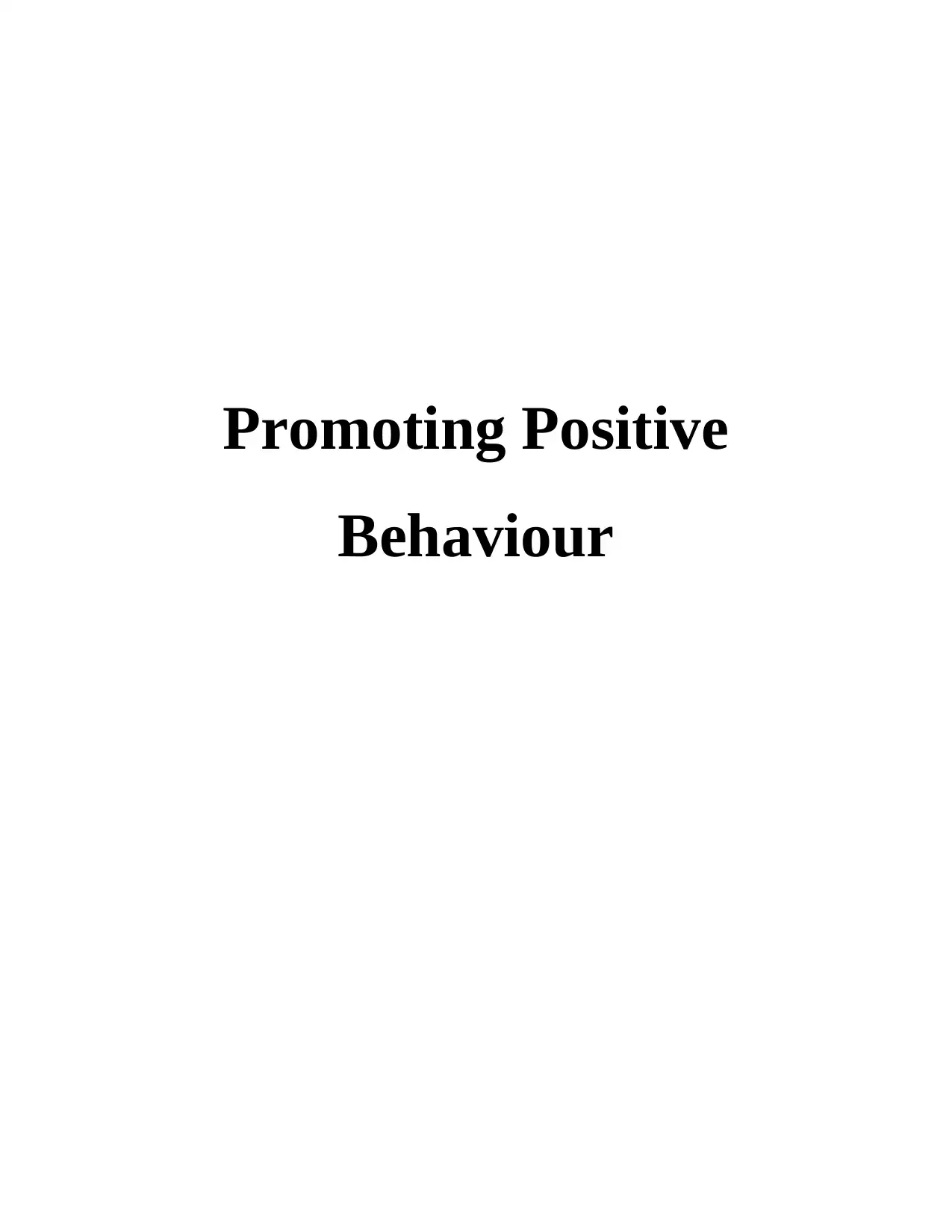
Promoting Positive
Behaviour
Behaviour
Paraphrase This Document
Need a fresh take? Get an instant paraphrase of this document with our AI Paraphraser
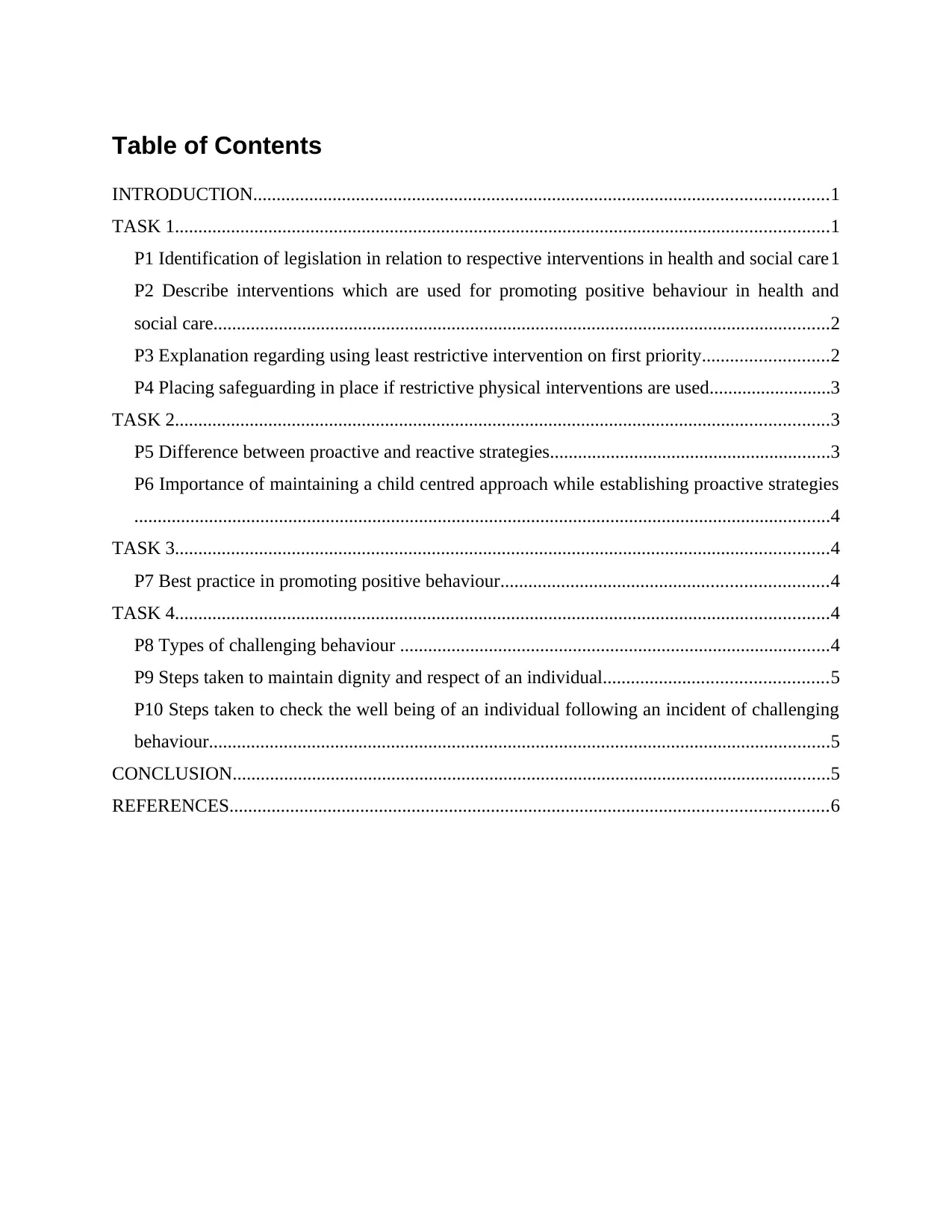
Table of Contents
INTRODUCTION...........................................................................................................................1
TASK 1............................................................................................................................................1
P1 Identification of legislation in relation to respective interventions in health and social care1
P2 Describe interventions which are used for promoting positive behaviour in health and
social care....................................................................................................................................2
P3 Explanation regarding using least restrictive intervention on first priority...........................2
P4 Placing safeguarding in place if restrictive physical interventions are used..........................3
TASK 2............................................................................................................................................3
P5 Difference between proactive and reactive strategies............................................................3
P6 Importance of maintaining a child centred approach while establishing proactive strategies
.....................................................................................................................................................4
TASK 3............................................................................................................................................4
P7 Best practice in promoting positive behaviour......................................................................4
TASK 4............................................................................................................................................4
P8 Types of challenging behaviour ............................................................................................4
P9 Steps taken to maintain dignity and respect of an individual................................................5
P10 Steps taken to check the well being of an individual following an incident of challenging
behaviour.....................................................................................................................................5
CONCLUSION................................................................................................................................5
REFERENCES................................................................................................................................6
INTRODUCTION...........................................................................................................................1
TASK 1............................................................................................................................................1
P1 Identification of legislation in relation to respective interventions in health and social care1
P2 Describe interventions which are used for promoting positive behaviour in health and
social care....................................................................................................................................2
P3 Explanation regarding using least restrictive intervention on first priority...........................2
P4 Placing safeguarding in place if restrictive physical interventions are used..........................3
TASK 2............................................................................................................................................3
P5 Difference between proactive and reactive strategies............................................................3
P6 Importance of maintaining a child centred approach while establishing proactive strategies
.....................................................................................................................................................4
TASK 3............................................................................................................................................4
P7 Best practice in promoting positive behaviour......................................................................4
TASK 4............................................................................................................................................4
P8 Types of challenging behaviour ............................................................................................4
P9 Steps taken to maintain dignity and respect of an individual................................................5
P10 Steps taken to check the well being of an individual following an incident of challenging
behaviour.....................................................................................................................................5
CONCLUSION................................................................................................................................5
REFERENCES................................................................................................................................6
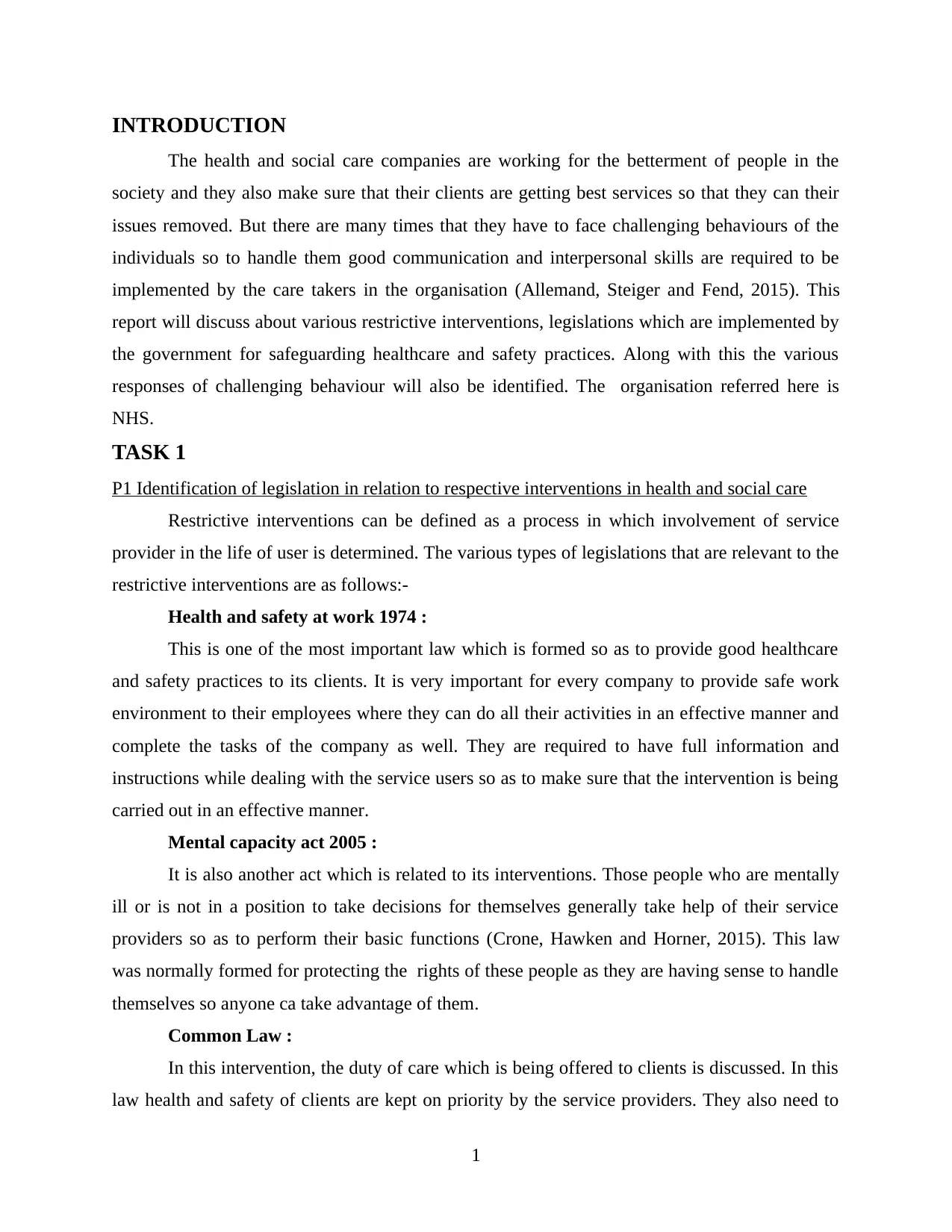
INTRODUCTION
The health and social care companies are working for the betterment of people in the
society and they also make sure that their clients are getting best services so that they can their
issues removed. But there are many times that they have to face challenging behaviours of the
individuals so to handle them good communication and interpersonal skills are required to be
implemented by the care takers in the organisation (Allemand, Steiger and Fend, 2015). This
report will discuss about various restrictive interventions, legislations which are implemented by
the government for safeguarding healthcare and safety practices. Along with this the various
responses of challenging behaviour will also be identified. The organisation referred here is
NHS.
TASK 1
P1 Identification of legislation in relation to respective interventions in health and social care
Restrictive interventions can be defined as a process in which involvement of service
provider in the life of user is determined. The various types of legislations that are relevant to the
restrictive interventions are as follows:-
Health and safety at work 1974 :
This is one of the most important law which is formed so as to provide good healthcare
and safety practices to its clients. It is very important for every company to provide safe work
environment to their employees where they can do all their activities in an effective manner and
complete the tasks of the company as well. They are required to have full information and
instructions while dealing with the service users so as to make sure that the intervention is being
carried out in an effective manner.
Mental capacity act 2005 :
It is also another act which is related to its interventions. Those people who are mentally
ill or is not in a position to take decisions for themselves generally take help of their service
providers so as to perform their basic functions (Crone, Hawken and Horner, 2015). This law
was normally formed for protecting the rights of these people as they are having sense to handle
themselves so anyone ca take advantage of them.
Common Law :
In this intervention, the duty of care which is being offered to clients is discussed. In this
law health and safety of clients are kept on priority by the service providers. They also need to
1
The health and social care companies are working for the betterment of people in the
society and they also make sure that their clients are getting best services so that they can their
issues removed. But there are many times that they have to face challenging behaviours of the
individuals so to handle them good communication and interpersonal skills are required to be
implemented by the care takers in the organisation (Allemand, Steiger and Fend, 2015). This
report will discuss about various restrictive interventions, legislations which are implemented by
the government for safeguarding healthcare and safety practices. Along with this the various
responses of challenging behaviour will also be identified. The organisation referred here is
NHS.
TASK 1
P1 Identification of legislation in relation to respective interventions in health and social care
Restrictive interventions can be defined as a process in which involvement of service
provider in the life of user is determined. The various types of legislations that are relevant to the
restrictive interventions are as follows:-
Health and safety at work 1974 :
This is one of the most important law which is formed so as to provide good healthcare
and safety practices to its clients. It is very important for every company to provide safe work
environment to their employees where they can do all their activities in an effective manner and
complete the tasks of the company as well. They are required to have full information and
instructions while dealing with the service users so as to make sure that the intervention is being
carried out in an effective manner.
Mental capacity act 2005 :
It is also another act which is related to its interventions. Those people who are mentally
ill or is not in a position to take decisions for themselves generally take help of their service
providers so as to perform their basic functions (Crone, Hawken and Horner, 2015). This law
was normally formed for protecting the rights of these people as they are having sense to handle
themselves so anyone ca take advantage of them.
Common Law :
In this intervention, the duty of care which is being offered to clients is discussed. In this
law health and safety of clients are kept on priority by the service providers. They also need to
1
⊘ This is a preview!⊘
Do you want full access?
Subscribe today to unlock all pages.

Trusted by 1+ million students worldwide
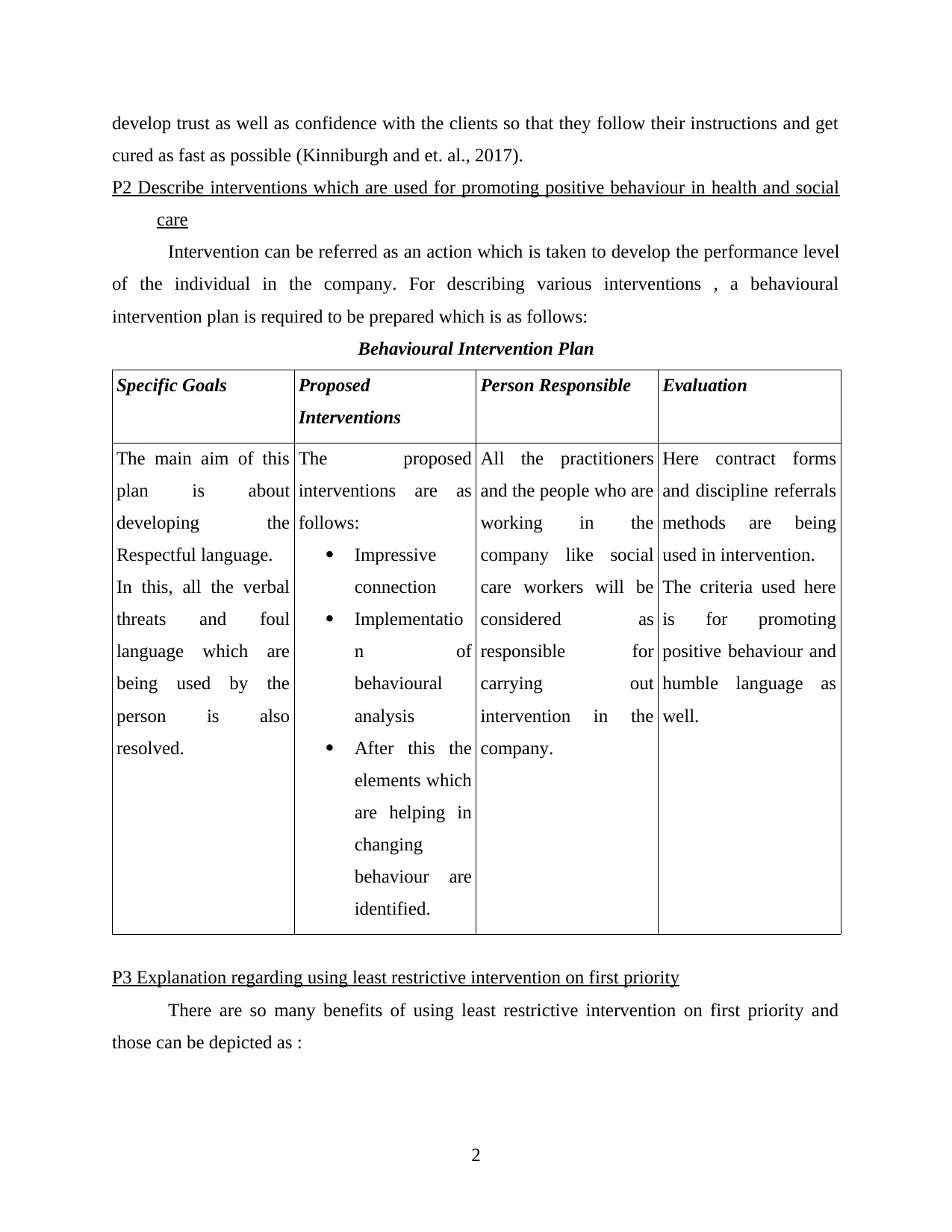
develop trust as well as confidence with the clients so that they follow their instructions and get
cured as fast as possible (Kinniburgh and et. al., 2017).
P2 Describe interventions which are used for promoting positive behaviour in health and social
care
Intervention can be referred as an action which is taken to develop the performance level
of the individual in the company. For describing various interventions , a behavioural
intervention plan is required to be prepared which is as follows:
Behavioural Intervention Plan
Specific Goals Proposed
Interventions
Person Responsible Evaluation
The main aim of this
plan is about
developing the
Respectful language.
In this, all the verbal
threats and foul
language which are
being used by the
person is also
resolved.
The proposed
interventions are as
follows:
Impressive
connection
Implementatio
n of
behavioural
analysis
After this the
elements which
are helping in
changing
behaviour are
identified.
All the practitioners
and the people who are
working in the
company like social
care workers will be
considered as
responsible for
carrying out
intervention in the
company.
Here contract forms
and discipline referrals
methods are being
used in intervention.
The criteria used here
is for promoting
positive behaviour and
humble language as
well.
P3 Explanation regarding using least restrictive intervention on first priority
There are so many benefits of using least restrictive intervention on first priority and
those can be depicted as :
2
cured as fast as possible (Kinniburgh and et. al., 2017).
P2 Describe interventions which are used for promoting positive behaviour in health and social
care
Intervention can be referred as an action which is taken to develop the performance level
of the individual in the company. For describing various interventions , a behavioural
intervention plan is required to be prepared which is as follows:
Behavioural Intervention Plan
Specific Goals Proposed
Interventions
Person Responsible Evaluation
The main aim of this
plan is about
developing the
Respectful language.
In this, all the verbal
threats and foul
language which are
being used by the
person is also
resolved.
The proposed
interventions are as
follows:
Impressive
connection
Implementatio
n of
behavioural
analysis
After this the
elements which
are helping in
changing
behaviour are
identified.
All the practitioners
and the people who are
working in the
company like social
care workers will be
considered as
responsible for
carrying out
intervention in the
company.
Here contract forms
and discipline referrals
methods are being
used in intervention.
The criteria used here
is for promoting
positive behaviour and
humble language as
well.
P3 Explanation regarding using least restrictive intervention on first priority
There are so many benefits of using least restrictive intervention on first priority and
those can be depicted as :
2
Paraphrase This Document
Need a fresh take? Get an instant paraphrase of this document with our AI Paraphraser
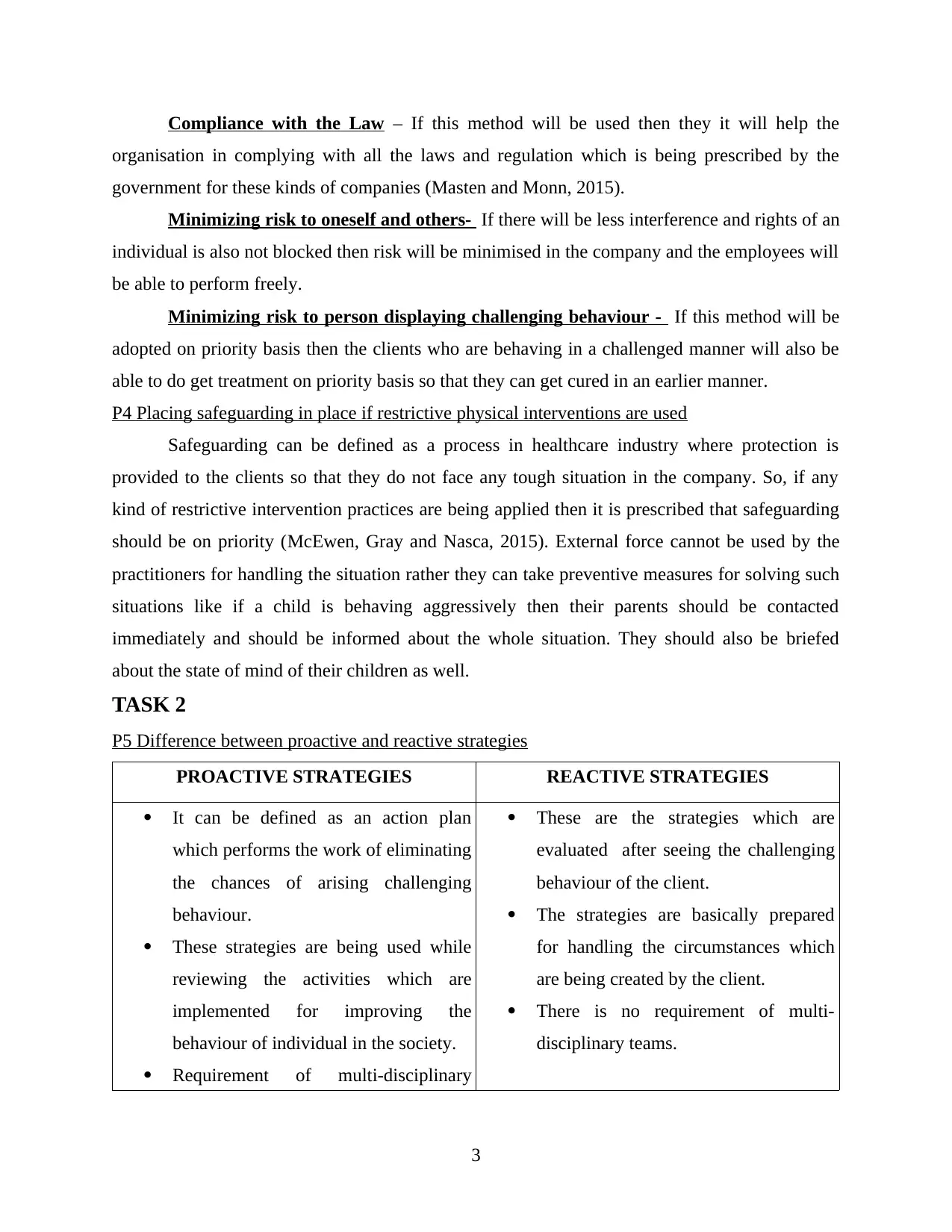
Compliance with the Law – If this method will be used then they it will help the
organisation in complying with all the laws and regulation which is being prescribed by the
government for these kinds of companies (Masten and Monn, 2015).
Minimizing risk to oneself and others- If there will be less interference and rights of an
individual is also not blocked then risk will be minimised in the company and the employees will
be able to perform freely.
Minimizing risk to person displaying challenging behaviour - If this method will be
adopted on priority basis then the clients who are behaving in a challenged manner will also be
able to do get treatment on priority basis so that they can get cured in an earlier manner.
P4 Placing safeguarding in place if restrictive physical interventions are used
Safeguarding can be defined as a process in healthcare industry where protection is
provided to the clients so that they do not face any tough situation in the company. So, if any
kind of restrictive intervention practices are being applied then it is prescribed that safeguarding
should be on priority (McEwen, Gray and Nasca, 2015). External force cannot be used by the
practitioners for handling the situation rather they can take preventive measures for solving such
situations like if a child is behaving aggressively then their parents should be contacted
immediately and should be informed about the whole situation. They should also be briefed
about the state of mind of their children as well.
TASK 2
P5 Difference between proactive and reactive strategies
PROACTIVE STRATEGIES REACTIVE STRATEGIES
It can be defined as an action plan
which performs the work of eliminating
the chances of arising challenging
behaviour.
These strategies are being used while
reviewing the activities which are
implemented for improving the
behaviour of individual in the society.
Requirement of multi-disciplinary
These are the strategies which are
evaluated after seeing the challenging
behaviour of the client.
The strategies are basically prepared
for handling the circumstances which
are being created by the client.
There is no requirement of multi-
disciplinary teams.
3
organisation in complying with all the laws and regulation which is being prescribed by the
government for these kinds of companies (Masten and Monn, 2015).
Minimizing risk to oneself and others- If there will be less interference and rights of an
individual is also not blocked then risk will be minimised in the company and the employees will
be able to perform freely.
Minimizing risk to person displaying challenging behaviour - If this method will be
adopted on priority basis then the clients who are behaving in a challenged manner will also be
able to do get treatment on priority basis so that they can get cured in an earlier manner.
P4 Placing safeguarding in place if restrictive physical interventions are used
Safeguarding can be defined as a process in healthcare industry where protection is
provided to the clients so that they do not face any tough situation in the company. So, if any
kind of restrictive intervention practices are being applied then it is prescribed that safeguarding
should be on priority (McEwen, Gray and Nasca, 2015). External force cannot be used by the
practitioners for handling the situation rather they can take preventive measures for solving such
situations like if a child is behaving aggressively then their parents should be contacted
immediately and should be informed about the whole situation. They should also be briefed
about the state of mind of their children as well.
TASK 2
P5 Difference between proactive and reactive strategies
PROACTIVE STRATEGIES REACTIVE STRATEGIES
It can be defined as an action plan
which performs the work of eliminating
the chances of arising challenging
behaviour.
These strategies are being used while
reviewing the activities which are
implemented for improving the
behaviour of individual in the society.
Requirement of multi-disciplinary
These are the strategies which are
evaluated after seeing the challenging
behaviour of the client.
The strategies are basically prepared
for handling the circumstances which
are being created by the client.
There is no requirement of multi-
disciplinary teams.
3
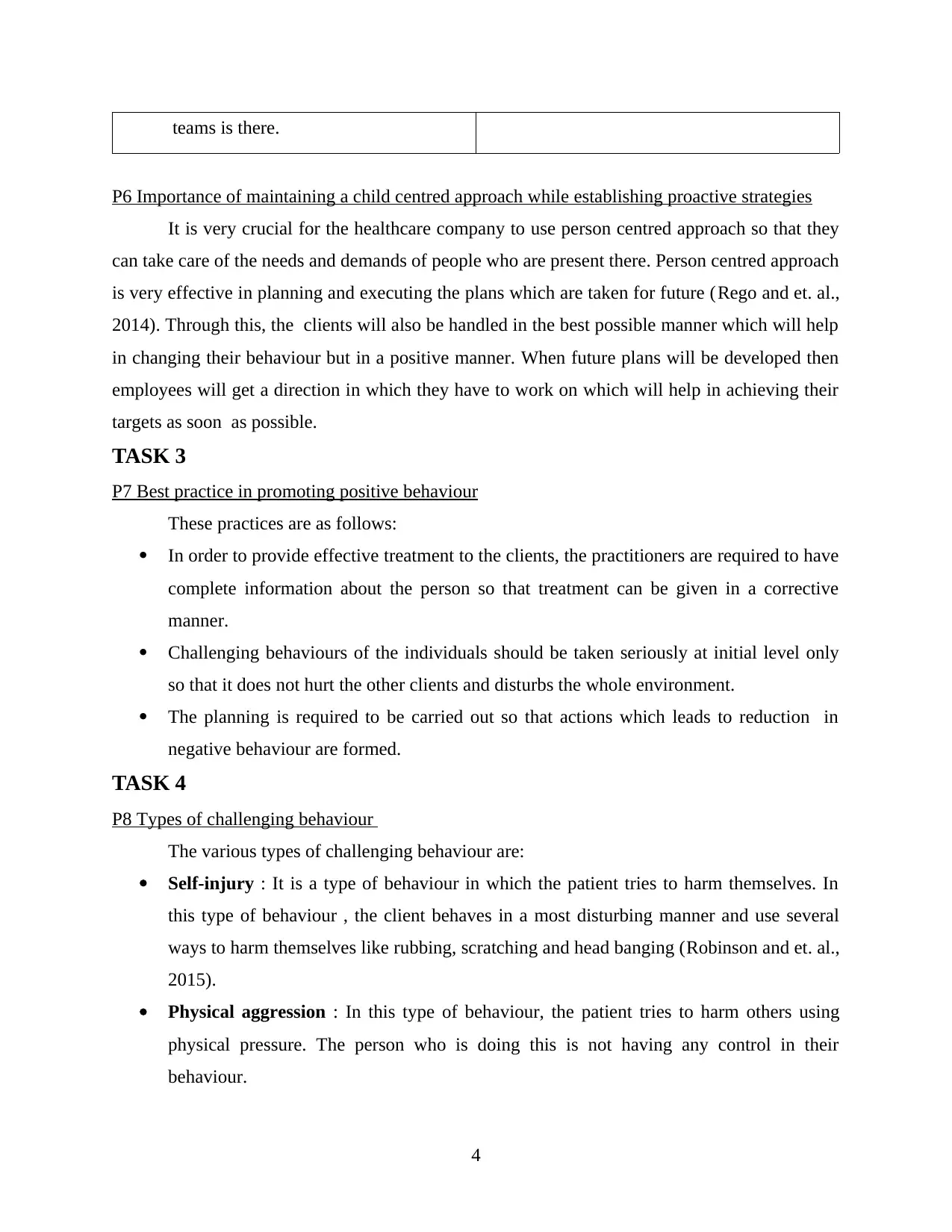
teams is there.
P6 Importance of maintaining a child centred approach while establishing proactive strategies
It is very crucial for the healthcare company to use person centred approach so that they
can take care of the needs and demands of people who are present there. Person centred approach
is very effective in planning and executing the plans which are taken for future (Rego and et. al.,
2014). Through this, the clients will also be handled in the best possible manner which will help
in changing their behaviour but in a positive manner. When future plans will be developed then
employees will get a direction in which they have to work on which will help in achieving their
targets as soon as possible.
TASK 3
P7 Best practice in promoting positive behaviour
These practices are as follows:
In order to provide effective treatment to the clients, the practitioners are required to have
complete information about the person so that treatment can be given in a corrective
manner.
Challenging behaviours of the individuals should be taken seriously at initial level only
so that it does not hurt the other clients and disturbs the whole environment.
The planning is required to be carried out so that actions which leads to reduction in
negative behaviour are formed.
TASK 4
P8 Types of challenging behaviour
The various types of challenging behaviour are:
Self-injury : It is a type of behaviour in which the patient tries to harm themselves. In
this type of behaviour , the client behaves in a most disturbing manner and use several
ways to harm themselves like rubbing, scratching and head banging (Robinson and et. al.,
2015).
Physical aggression : In this type of behaviour, the patient tries to harm others using
physical pressure. The person who is doing this is not having any control in their
behaviour.
4
P6 Importance of maintaining a child centred approach while establishing proactive strategies
It is very crucial for the healthcare company to use person centred approach so that they
can take care of the needs and demands of people who are present there. Person centred approach
is very effective in planning and executing the plans which are taken for future (Rego and et. al.,
2014). Through this, the clients will also be handled in the best possible manner which will help
in changing their behaviour but in a positive manner. When future plans will be developed then
employees will get a direction in which they have to work on which will help in achieving their
targets as soon as possible.
TASK 3
P7 Best practice in promoting positive behaviour
These practices are as follows:
In order to provide effective treatment to the clients, the practitioners are required to have
complete information about the person so that treatment can be given in a corrective
manner.
Challenging behaviours of the individuals should be taken seriously at initial level only
so that it does not hurt the other clients and disturbs the whole environment.
The planning is required to be carried out so that actions which leads to reduction in
negative behaviour are formed.
TASK 4
P8 Types of challenging behaviour
The various types of challenging behaviour are:
Self-injury : It is a type of behaviour in which the patient tries to harm themselves. In
this type of behaviour , the client behaves in a most disturbing manner and use several
ways to harm themselves like rubbing, scratching and head banging (Robinson and et. al.,
2015).
Physical aggression : In this type of behaviour, the patient tries to harm others using
physical pressure. The person who is doing this is not having any control in their
behaviour.
4
⊘ This is a preview!⊘
Do you want full access?
Subscribe today to unlock all pages.

Trusted by 1+ million students worldwide
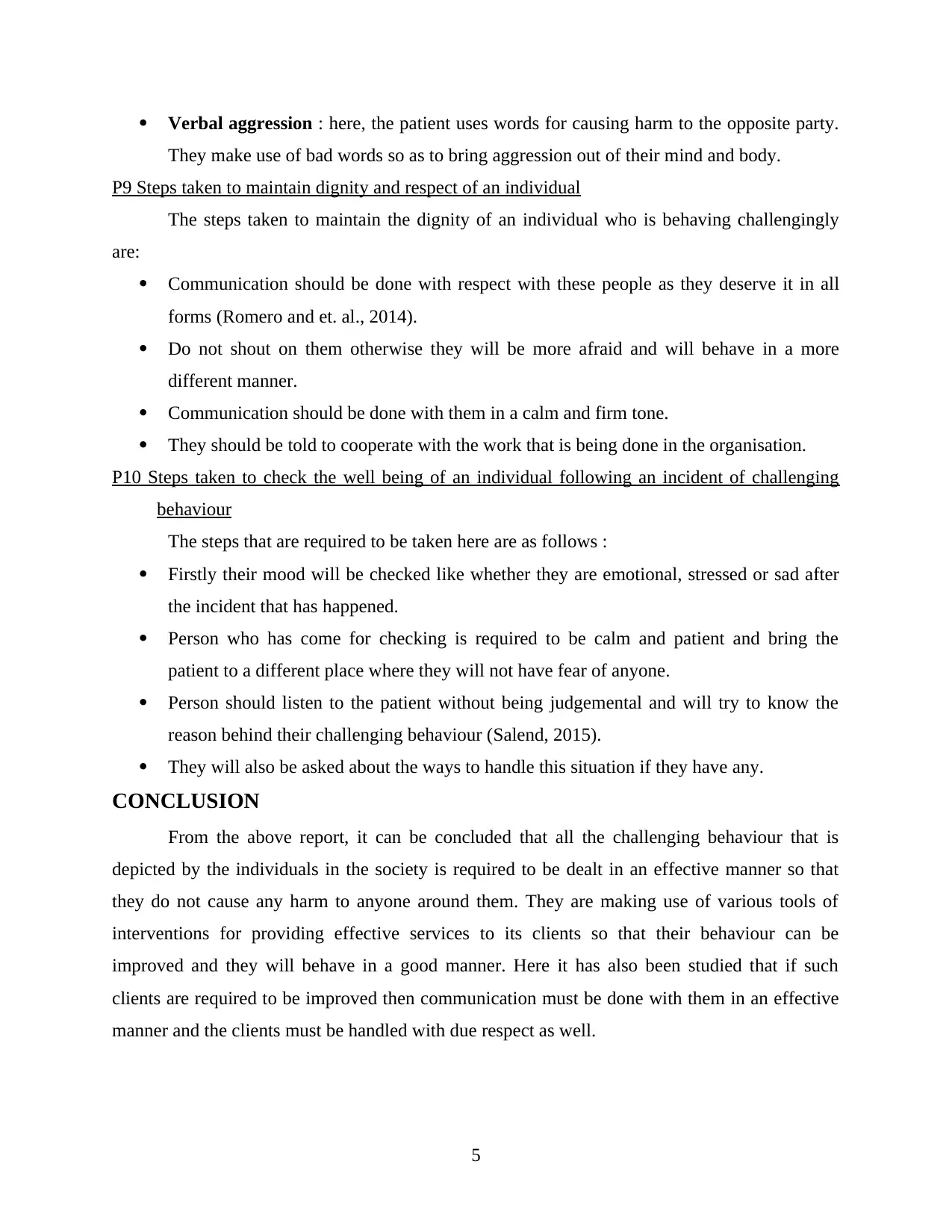
Verbal aggression : here, the patient uses words for causing harm to the opposite party.
They make use of bad words so as to bring aggression out of their mind and body.
P9 Steps taken to maintain dignity and respect of an individual
The steps taken to maintain the dignity of an individual who is behaving challengingly
are:
Communication should be done with respect with these people as they deserve it in all
forms (Romero and et. al., 2014).
Do not shout on them otherwise they will be more afraid and will behave in a more
different manner.
Communication should be done with them in a calm and firm tone.
They should be told to cooperate with the work that is being done in the organisation.
P10 Steps taken to check the well being of an individual following an incident of challenging
behaviour
The steps that are required to be taken here are as follows :
Firstly their mood will be checked like whether they are emotional, stressed or sad after
the incident that has happened.
Person who has come for checking is required to be calm and patient and bring the
patient to a different place where they will not have fear of anyone.
Person should listen to the patient without being judgemental and will try to know the
reason behind their challenging behaviour (Salend, 2015).
They will also be asked about the ways to handle this situation if they have any.
CONCLUSION
From the above report, it can be concluded that all the challenging behaviour that is
depicted by the individuals in the society is required to be dealt in an effective manner so that
they do not cause any harm to anyone around them. They are making use of various tools of
interventions for providing effective services to its clients so that their behaviour can be
improved and they will behave in a good manner. Here it has also been studied that if such
clients are required to be improved then communication must be done with them in an effective
manner and the clients must be handled with due respect as well.
5
They make use of bad words so as to bring aggression out of their mind and body.
P9 Steps taken to maintain dignity and respect of an individual
The steps taken to maintain the dignity of an individual who is behaving challengingly
are:
Communication should be done with respect with these people as they deserve it in all
forms (Romero and et. al., 2014).
Do not shout on them otherwise they will be more afraid and will behave in a more
different manner.
Communication should be done with them in a calm and firm tone.
They should be told to cooperate with the work that is being done in the organisation.
P10 Steps taken to check the well being of an individual following an incident of challenging
behaviour
The steps that are required to be taken here are as follows :
Firstly their mood will be checked like whether they are emotional, stressed or sad after
the incident that has happened.
Person who has come for checking is required to be calm and patient and bring the
patient to a different place where they will not have fear of anyone.
Person should listen to the patient without being judgemental and will try to know the
reason behind their challenging behaviour (Salend, 2015).
They will also be asked about the ways to handle this situation if they have any.
CONCLUSION
From the above report, it can be concluded that all the challenging behaviour that is
depicted by the individuals in the society is required to be dealt in an effective manner so that
they do not cause any harm to anyone around them. They are making use of various tools of
interventions for providing effective services to its clients so that their behaviour can be
improved and they will behave in a good manner. Here it has also been studied that if such
clients are required to be improved then communication must be done with them in an effective
manner and the clients must be handled with due respect as well.
5
Paraphrase This Document
Need a fresh take? Get an instant paraphrase of this document with our AI Paraphraser
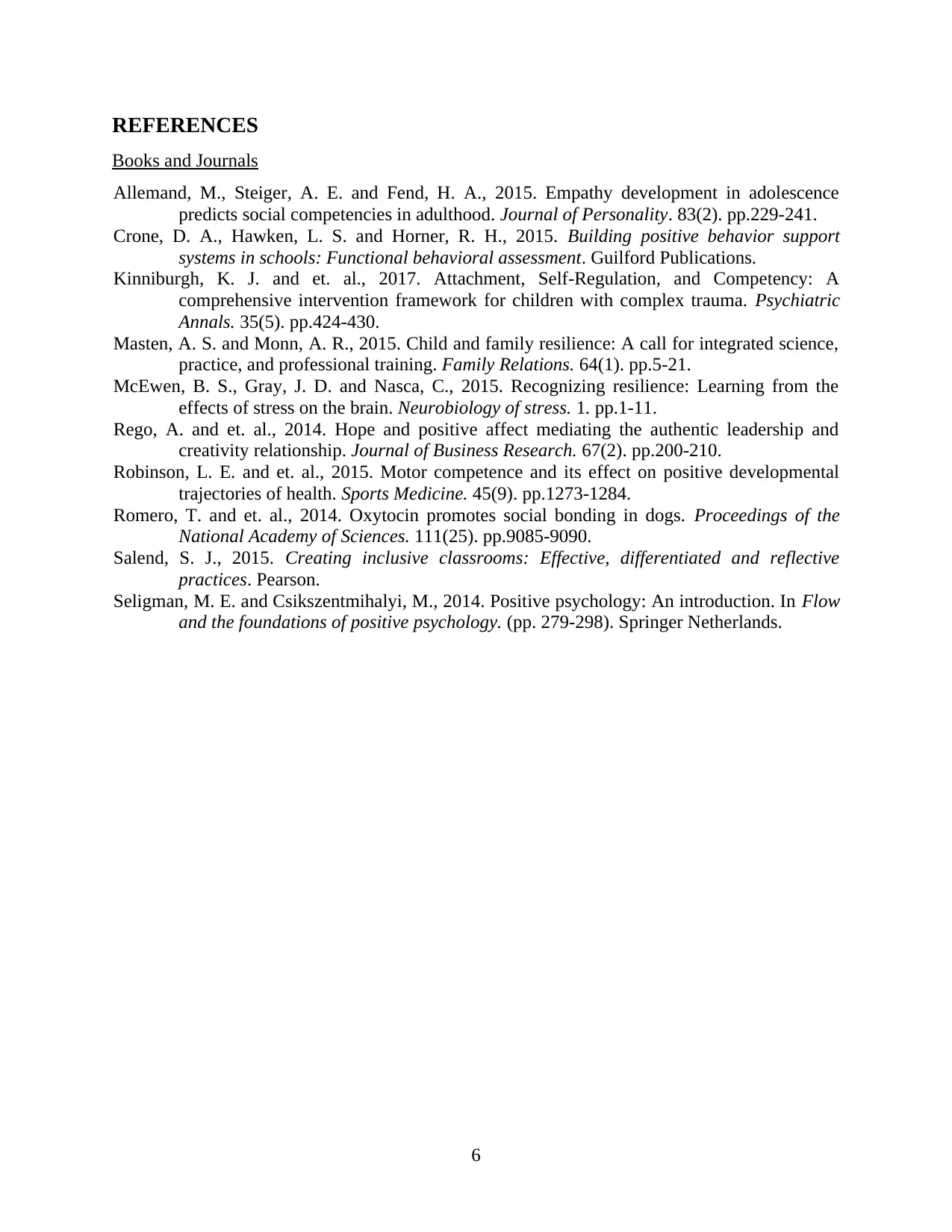
REFERENCES
Books and Journals
Allemand, M., Steiger, A. E. and Fend, H. A., 2015. Empathy development in adolescence
predicts social competencies in adulthood. Journal of Personality. 83(2). pp.229-241.
Crone, D. A., Hawken, L. S. and Horner, R. H., 2015. Building positive behavior support
systems in schools: Functional behavioral assessment. Guilford Publications.
Kinniburgh, K. J. and et. al., 2017. Attachment, Self-Regulation, and Competency: A
comprehensive intervention framework for children with complex trauma. Psychiatric
Annals. 35(5). pp.424-430.
Masten, A. S. and Monn, A. R., 2015. Child and family resilience: A call for integrated science,
practice, and professional training. Family Relations. 64(1). pp.5-21.
McEwen, B. S., Gray, J. D. and Nasca, C., 2015. Recognizing resilience: Learning from the
effects of stress on the brain. Neurobiology of stress. 1. pp.1-11.
Rego, A. and et. al., 2014. Hope and positive affect mediating the authentic leadership and
creativity relationship. Journal of Business Research. 67(2). pp.200-210.
Robinson, L. E. and et. al., 2015. Motor competence and its effect on positive developmental
trajectories of health. Sports Medicine. 45(9). pp.1273-1284.
Romero, T. and et. al., 2014. Oxytocin promotes social bonding in dogs. Proceedings of the
National Academy of Sciences. 111(25). pp.9085-9090.
Salend, S. J., 2015. Creating inclusive classrooms: Effective, differentiated and reflective
practices. Pearson.
Seligman, M. E. and Csikszentmihalyi, M., 2014. Positive psychology: An introduction. In Flow
and the foundations of positive psychology. (pp. 279-298). Springer Netherlands.
6
Books and Journals
Allemand, M., Steiger, A. E. and Fend, H. A., 2015. Empathy development in adolescence
predicts social competencies in adulthood. Journal of Personality. 83(2). pp.229-241.
Crone, D. A., Hawken, L. S. and Horner, R. H., 2015. Building positive behavior support
systems in schools: Functional behavioral assessment. Guilford Publications.
Kinniburgh, K. J. and et. al., 2017. Attachment, Self-Regulation, and Competency: A
comprehensive intervention framework for children with complex trauma. Psychiatric
Annals. 35(5). pp.424-430.
Masten, A. S. and Monn, A. R., 2015. Child and family resilience: A call for integrated science,
practice, and professional training. Family Relations. 64(1). pp.5-21.
McEwen, B. S., Gray, J. D. and Nasca, C., 2015. Recognizing resilience: Learning from the
effects of stress on the brain. Neurobiology of stress. 1. pp.1-11.
Rego, A. and et. al., 2014. Hope and positive affect mediating the authentic leadership and
creativity relationship. Journal of Business Research. 67(2). pp.200-210.
Robinson, L. E. and et. al., 2015. Motor competence and its effect on positive developmental
trajectories of health. Sports Medicine. 45(9). pp.1273-1284.
Romero, T. and et. al., 2014. Oxytocin promotes social bonding in dogs. Proceedings of the
National Academy of Sciences. 111(25). pp.9085-9090.
Salend, S. J., 2015. Creating inclusive classrooms: Effective, differentiated and reflective
practices. Pearson.
Seligman, M. E. and Csikszentmihalyi, M., 2014. Positive psychology: An introduction. In Flow
and the foundations of positive psychology. (pp. 279-298). Springer Netherlands.
6
1 out of 8
Related Documents
Your All-in-One AI-Powered Toolkit for Academic Success.
+13062052269
info@desklib.com
Available 24*7 on WhatsApp / Email
![[object Object]](/_next/static/media/star-bottom.7253800d.svg)
Unlock your academic potential
Copyright © 2020–2025 A2Z Services. All Rights Reserved. Developed and managed by ZUCOL.





